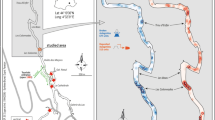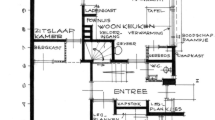Abstract
In one form or another, the sewn-plank boats have been in existence along the Swahili coast of East Africa since at least the first century CE. Although the last such vessel type known later as mtepe vanished in the mid-1930s in Lamu Archipelago, Kenya, a research reconstruction was built in Zanzibar in 2003. It was originally housed in the House of Wonders as part of a large exhibit on the Dhow Cultures of the Indian Ocean. Due to a tragic collapse of the museum’s roof, the mtepe reconstruction named Shungwaya had to be moved to an open outdoor space in 2020. Since then, it has remained unprotected and exposed to the elements, which contributed to further deterioration and damage. The aim of this article is to expand on the initial work related to the reconstruction of Shungwaya, provide documentation and analysis of the structure of this research model and museum exhibit, produce a digital record, and provide ship lines and drawings. The article also draws attention to the importance of preserving vernacular shipbuilding traditions and culture through models, full-scale reconstructions, documentations, interpretations, and museum exhibitions.
Résumé
Sous une forme ou une autre, les bateaux en planches cousues existent le long de la côte Swahili de l'Afrique de l'Est depuis au moins le 1er siècle de notre ère. Bien que le dernier type de navire connu plus tard sous le nom de mtepe ait disparu au milieu des années 1930 dans l'Archipel de Lamu, au Kenya, une reconstruction de recherche a été construite à Zanzibar en 2003. Il était à l'origine installé dans la Maison des Merveilles dans le cadre d'une grande exposition sur le boutre. Cultures de l'océan Indien. En raison d’un effondrement tragique du toit du musée, le mtepe reconstitué nommé Shungwaya a dû être déplacé vers un espace extérieur ouvert en 2020. Depuis lors, il est resté sans protection et exposé aux éléments, ce qui a contribué à davantage de détérioration et de dommages. Le but de cet article est de développer les travaux initiaux liés à la reconstruction de Shungwaya, de fournir une documentation et une analyse de la structure de ce modèle de recherche et de cette exposition muséale, de produire un enregistrement numérique et de fournir des lignes et des dessins de navires. L’article attire également l’attention sur l’importance de préserver les traditions et la culture vernaculaires de la construction navale à travers des maquettes, des reconstructions à grande échelle, des documentations, des interprétations et des expositions de musée.



























Similar content being viewed by others
Data Availability
The data that support the findings of this study are available by request through J. Richard Steffy Ship Reconstruction Laboratory, Nautical Archaeology Program, Department of Anthropology, Texas A&M University.
References
Adams, R. M. (1985). Designed flexibility in a sewn boat of the western Indian Ocean. In S. McGrail & E. Kentley (Eds.), Sewn plank boats: Archaeological and ethnographic papers based on those presented to a conference at Greenwich in November (pp. 289–302). BAR Publishing.
Batuta, Ibn, & Bivar, A. D. H. (2000). The travels of Ibn Baṭṭūṭa, A.D. 1325–1354. Hakluyt Society.
Baumann, O. (1899). Der Sansibar-Archipel: Ergebnisse einer mit Unterstützung des Vereins für Erdkunde zu Leipzig 1895/96 ausgeführten Forschungsreise. Duncker & Humbolt.
Burton, R. F. (1872). Zanzibar: City island and coast (Vol. 1). Tinsley Brothers.
Casson, L. (1989). The Periplus Maris Erythraei: Text with introduction, translation, and commentary. Princeton University Press.
Chittick, N. (1974). Kilwa: An islamic trading city on the East African coast. British Institute in Eastern Africa.
Chittick, N. (1980). Sewn boats in the western Indian Ocean, and a survival in Somalia. International Journal of Nautical Archaeology, 9(4), 297–309.
Cooper, J. P., & Ghidoni, A. (2022). Ship graffiti at the Zanzibar Gereza (Old Fort), Stone Town, Unguja, Tanzania. Azania: Archaeological Research in Africa, 57(1), 90–120. https://doi.org/10.1080/0067270X.2022.2047526
Cooper, J. P., Ghidoni, A., Zazzaro, C., & Ombrato, L. (2020). Sewn boats in the Qatar Museums collection, Doha: Baggāras and kettuvallams as records of a western Indian Ocean technological tradition. International Journal of Nautical Archaeology, 49(2), 371–405. https://doi.org/10.1111/1095-9270.12422
Cooper, J. P., Blue, L., Ghidoni, A., & Ichumbaki, E. B. (2021). Contemporary wooden watercraft of the Zanzibar channel, Tanzania: Type and technology, continuity and innovation. International Journal of Nautical Archaeology, 50(2), 243–271. https://doi.org/10.1080/10572414.2021.2015913
De Leeuwe, R. (2005). Constructing sailing ships on the Swahili shores. Azania: Journal of the British Institute in Eastern Africa, 40(1), 107–113. https://doi.org/10.1080/00672700509480416
De Leeuwe, R. (2004). Seascape and sailing ships of the Swahili shores. Master’s dissertation. University of Leiden.
Dixon, C. (2019). Models as evidence for sewn-boat traditions. International Journal of Nautical Archaeology, 48(2), 286–301. https://doi.org/10.1111/1095-9270.12363
Dixon, C. (2018). Sailing the monsoon winds in miniature: Model boats as evidence for boat building technologies, cultures and collecting. Doctoral thesis: 385. University of Southampton.
Elliot, J. A. G. (1926). A visit to the Bajun Islands: Part II. Journal of the Royal African Society, 25(99), 245–263.
El-Tahtawy, H. (1972). Die Ausfuhrgüter Der Ostafrikanischen Küste Im Mittelalter Nach Zeitgenössischen Berichten Islamischer Autoren Ein Beitrag Zur Geschichte Des Afrikanischen Handels. Verlag Notring.
Ettinghausen, R. (1962). Arab painting. The World Publishing Company.
Garlake, P., & Garlake, M. (1964). Early ship engravings of the East African coast. Tanz Notes Records, 63, 197–206.
Ghidoni, A. (2023). Ship timbers from the Islamic sites of al-Balid and Qalhat, Oman: Sewn-plank technology in the Indian Ocean during the 10–16th centuries CE. BAR Publishing. https://doi.org/10.30861/9781407360577
Gilbert, E. (1998). The Mtepe: Regional trade and the late survival of sewn ships in East African waters. International Journal of Nautical Archaeology, 27(1), 43–50.
Grottanelli, V. L. (1955). Pescatori dell’oceano indiano: saggio etnologico preliminare sui bagiuni, bantu costieri dell'oltregiuba. Roma, Edizione Cremonese.
Hornell, J. (1941). The sea-going Mtepe and Dau of the Lamu Archipelago. Mariner’s Mirror, 27(1), 54–68.
Hourani, G. F. (1963). Arab seafaring in the Indian Ocean in ancient and early medieval times. Princeton Oriental Studies.
House of Wonders, & Zanzibar National Museum of History and Culture. (2004). The Mtepe ‘Shungwaya,’ an ancient Swahili vessel, sails again [printed poster]. Zanzibar: Bega kwa bega production.
Hughes, C., & Post, R. (2016). A GIS Approach to finding the metropolis of Rhapta. In G. Campbell (Ed.), Early exchange between Africa and the wider Indian Ocean world (pp. 135–155). Palgrave Macmillan.
Huntingford, G. W. B. (Ed.). (2010). The Periplus of the Erythraean Sea, by an unknown author: With some extracts from Agatharkhides ‘on the Erythraean Sea.’ Hakluyt Society. https://doi.org/10.4324/9781315554754
Kirkman, J. S. (1974). Fort Jesus: A Portuguese fortress on the east African coast. Clarendon Press.
Lichtenstein, A. (2020). Iconic House of Wonders collapse leaves Zanzibaris wondering about fate of cultural heritage. GlobalVoices. https://globalvoices.org/2020/12/28/iconic-house-of-wonders-collapse-leaves-zanzibaris-wondering-about-fate-of-cultural-heritage/#:~:text=The%20collapse%20came%20as%20a,collapse%20on%20December%2025%2C%202020. Accessed 22 Aug 2023.
Lydekker, C. J. W. (1919). 46. The ‘Mtepe’ Dhau of the Bajun Islands. Man, 19, 88–92. https://doi.org/10.2307/2840608. JSTOR.
Martin, E. B., & Martin, C. P. (1978). Cargoes of the east. Elm Tree Books.
Morton, R. F. (1972). The Shungwaya myth of Miji Kenda origins: A problem of late nineteenth-century Kenya coastal history. The International Journal of African Historical Studies, 5(3), 397–423. https://doi.org/10.2307/217092
Parsons, M. G. (2003). Chapter 11: Parametric design. In T. Lamb (Ed.), Ship design and construction vol. 1 and 2. (pp. 11: 15). Jersey City: Society of Naval Architects and Marine Engineers. https://www.highlightcomputer.com/NArch%20502%20%20Ship%20Design%20and%20Construction.pdf. Accessed 4 Oct 2023.
Pedersen, R. K. (2003). The boatbuilding sequence in the Gilgamesh epic and the sewn boat relation anthropology. Doctoral thesis. Texas A&M University.
Pedersen, R. K. (2004). Traditional Arabian watercraft and the ark of the Gilgamesh epic: interpretations and realizations. Proceedings of the Seminar for Arabian Studies, 34, 231–238. http://www.jstor.org/stable/41223820. Accessed 15 Sep 2023.
Poumailloux, P. (1999). Le “Mtepe”, bateau cousu des Swahili, suivi d’un glossaire technique. Études Océan Indien, 27–28, 227–328.
Prins, A. H. J. (1959). Uncertainties in coastal history: The Ngalawa and the Mtepe. Tanganyika. Notes and Records, 53, 205–213.
Prins, A. H. J. (1965). Sailing from Lamu: A study of maritime culture in Islamic East Africa. Van Gorcum.
Prins, A. H. J. (1982). The Mtepe of Lamu, Mombasa and the Zanzibar sea. Paideuma Nitteilungen Zur Kulturkunde, 28, 85–100.
Prins, A. H. J. (1986). A handbook of sewn boats: The ethnography and archaeology of archaic plank-built craft. Trustees of the National Maritime Museum.
Ravenstein, E. (Ed. and Trans.) (1898). Journal of the first voyage of Vasco da Gama 1497–1498. Translated from Portuguese. Hakluyt Society. https://ia800703.us.archive.org/15/items/worksissuedbyha00unkngoog/worksissuedbyha00unkngoog.pdf. Accessed 23 Dec 2023.
Révoil, G. (1888). Voyage chez les Benadirs, les Comalis et les Bayouns en 1882 et 1883. La Tour Du Monde, 56, 385–416.
Sawyer, A. (2013). Salvage stories, preserving narratives, and museum ships. Museum and Society, 11(3), 242–257.
Schoff, W. H. (1974). The periplus of the Erythraean Sea: Travel and trade in the Indian Ocean by a merchant of the first century. Oriental Books.
Sheriff, A., Abdalla, K. A., & Mshenga, A. I. (2006). The mtepe ‘Shungwaya’ sails again. Ziff Journal, 3, 35–44.
Staples, E., & Blue, L. (2019). Archaeological, historical, and ethnographic approaches to the study of sewn boats: Past, present, and future. International Journal of Nautical Archaeology, 48(2), 269–285. https://doi.org/10.1111/1095-9270.12361
Tupper, E. C. (2004). Introduction to naval architecture. Elsevier Butterworth Heinemann.
Voeltzkow, A. (1923). Witu-Inseln und Zanzibar-Archipel. (pp. 42–44, Abb. 18). Stuttgart: E. Schweizerbartsche.
Weisauer, E. (1976). Die genähten boote der Ostafrikanischen küste anhand von quellen des 19. und frühen 20. Jahrhunderts. Wiener Ethnohistorische Blätter, 11, 73–96.
Acknowledgements
The authors would like to thank the House of Wonders, the Peace Memorial Museum, and the Ministry of Heritage and Tourism, Department of Museums and Antiquities in Zanzibar for the support these institutions provided to this project and a larger (ongoing) ship ethnography initiative in Zanzibar, Tanzania. In particular, the authors would like to thank Dr. Abdul Sheriff, other associated museum personnel, and local volunteers who lent their time and expertise. As per agreement with the authors, Sheriff offered an extensive oral account and a collection of published and unpublished sources related to the construction process of Shungwaya. The permission for the project was granted by the Ministry of Heritage and Tourism, Department of Museums and Antiquities, Zanzibar.
Funding
Partial funding was provided by the Institute of Nautical Archaeology (INA), USA, and the Texas A&M University, College Station, TX, USA.
Author information
Authors and Affiliations
Corresponding author
Additional information
Publisher's Note
Springer Nature remains neutral with regard to jurisdictional claims in published maps and institutional affiliations.
Archaeological time period
Late 19th to twentieth century
Country and region discussed
Tanzania, Unguja (Zanzibar)
Rights and permissions
Springer Nature or its licensor (e.g. a society or other partner) holds exclusive rights to this article under a publishing agreement with the author(s) or other rightsholder(s); author self-archiving of the accepted manuscript version of this article is solely governed by the terms of such publishing agreement and applicable law.
About this article
Cite this article
Bojakowski, P.T., Sarathi, A., Berrocal, R.P. et al. Mtepe: Documentation and Analysis of a Sewn-Boat Reconstruction from Zanzibar, Tanzania. Afr Archaeol Rev 41, 139–159 (2024). https://doi.org/10.1007/s10437-024-09577-6
Accepted:
Published:
Issue Date:
DOI: https://doi.org/10.1007/s10437-024-09577-6




